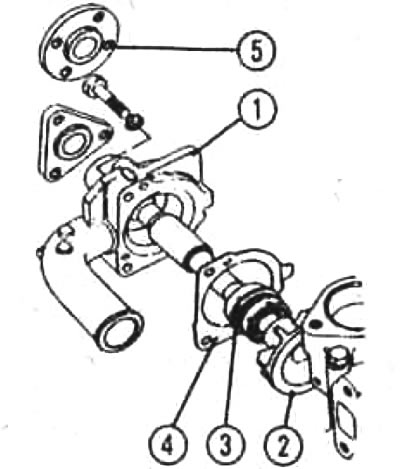
Schematic representation of a water pump (centrifugal pump): 1 - pump housing; 2 - pump wheel (centrifugal wheel); 3 - drive shaft; 4 - gasket; 5 - drive wheel (belt pulley).
Radiator: consists of synthetic water boxes on each side. Both boxes are connected to each other by many thin-walled tubes. In order to repeatedly increase the surface of the radiator, there are plates folded like an accordion between the tubes: they remove excess heat directly into the oncoming air flow. The Focus radiator is fixed to the top and bottom cross members.
Thermostat: maintains a constant coolant temperature. New thermostats, depending on the engine model, open at 85-90°C, fully open at 99-102°C. Used thermostats have a tolerance of±3°C. Thermostats consist of a closed thermocouple filled with a special wax (cylinder), pressure spring and valve disc. To the extent that the fluid in the engine heats up, the wax expands in the thermocouple and lifts the valve disc in its seat, overcoming the resistance of the compression spring. The valve is fully open only at operating temperature. If the liquid cools down, the spring presses on the valve plate and accordingly blocks the flow.
Expansion tank: automatically supplements the amount of coolant circulating in the cooling system. Excessive pressure in the system is relieved through the overpressure valve in the seal cap of the tank, the reduced pressure equalizes the second valve in the seal cap. A transparent plastic tank is located on the right in the direction of travel in the engine compartment.
Radiator fan: all Focus engines have an electrically driven fan. The fan is also often referred to as a cooling fan.
Visitor comments